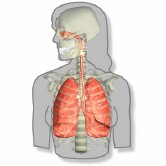MONDAY, Jan. 24 (HealthDay News) — People with chronic obstructive pulmonary disease are more likely today than in the past to die from cardiovascular disease or other conditions that are not respiratory ailments, a new Swedish study has found.
 Expert urges more awareness from doctors as patients’ age increases.
Expert urges more awareness from doctors as patients’ age increases.
This suggests that doctors need to be more aware of these risks when treating people with COPD, as the condition is known.
In recent years, the average age of COPD patients beginning long-term oxygen therapy has grown in Sweden from 66 to 73 years, Dr. Magnus P. Ekstrom, respiratory medicine physician and researcher at Blekinge Hospital in Karlskrona, Sweden, said in a news release from the American Thoracic Society. The proportion of women starting the therapy also has increased, said Ekstrom, who worked on the study.
“We wanted to determine if these changes had resulted in a shift in the causes of death for COPD patients with long-term oxygen therapy,” he said of the study, published online Jan. 7 in the American Journal of Respiratory and Critical Care Medicine.
The researchers analyzed data on 7,628 adults who began long-term oxygen therapy for COPD between 1987 and 2004. During the study, which followed the participants for an average of 1.7 years, 5,497 of them died.
Lung cancer and respiratory disease became less common causes of death each year, but the risk for circulatory and digestive organ disease both grew, the study found. Overall, the risk for death from cardiovascular disease increased by almost 62 percent, according to the study.
The difference seemed to be due, at least in part, to the older age of people starting oxygen therapy, the study found. “Tobacco exposure has decreased overall in Sweden, resulting in a delay in the decline of lung function, which means patients are generally older when they require” oxygen therapy, Ekstrom said. “However, although smoking has decreased overall, the rate of decrease has been greater in men than in women.”
Because people are older when starting therapy for COPD, they “have a progressively higher burden of coexisting diseases and conditions, and become more vulnerable with increasing age,” he said. Because of this, Ekstrom added, doctors treating COPD with long-term oxygen therapy “need to be aware of these shifts and to monitor for other conditions that may influence the risk of death in these patients.”
More information
The U.S. National Heart, Lung and Blood Institute has more on COPD.
SOURCE: American Thoracic Society, news release, Jan. 20, 2011
Copyright © 2011 HealthDay. All rights reserved.
![]()
